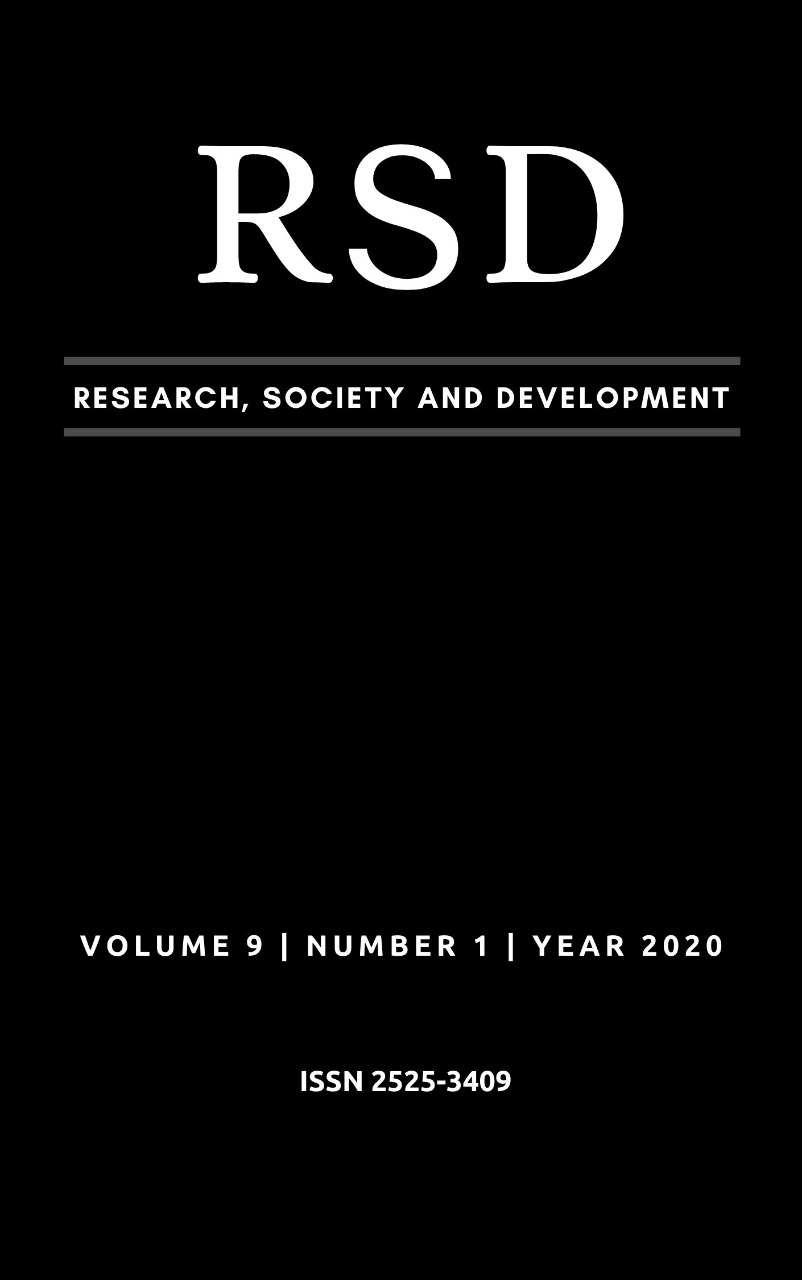Intenção de amamentar das gestantes atendidas no serviço público de saúde de Santa Maria - Rio Grande do Sul
DOI:
https://doi.org/10.33448/rsd-v9i1.1863Palavras-chave:
Aleitamento Materno, Amamentação, Gestantes, Gestação, IntençãoResumo
Objetivou-se analisar a intenção materna de amamentar de gestantes e os fatores associados. Foi realizado um estudo transversal com 94 grávidas atendidas no serviço público de saúde de um município do Sul do Brasil. Foi realizada Análise de Regressão Logística de Poisson para avaliar as associações. Noventa e três gestantes apresentaram intenção de amamentar, 89 tinham intenção de realizar o aleitamento materno exclusivo e 62 (70,45%) pretendiam realizá-lo por 6 meses. Não houve associação entre intenção de amamentar de forma exclusiva por seis meses e as variáveis independentes estudadas. A maioria das mulheres tinham intenção de amamentar, porém somente 15 pretendiam realizar o aleitamento materno por mais de 6 meses. Concluí-se que os profissionais da saúde devem agir como influenciadores da intenção de amamentar, auxiliando nessa decisão importante para a saúde do binômio mãe-bebê.
Referências
Bai, Y., Wunderlich, S. M. & Fly AD (2011). Predicting Intentions to Continue Exclusive Breastfeeding for 6 Months: a Comparison Among Racial/Ethnic Groups. Matern Child Health J, 5:1257-1264.
Denis, C. L (2002). Breastfeeding initiation and duration: a 1990-2000 literature review. J Obstet Gynecol Neonatal Nurs, 31:12-32.
Di Mattei, V. E., Carnelli, L., Bernardi, M., Jongerius, C., Brombin, C., Cugnata, F., et al (2016). Identification of Socio-demographic and Psychological Factors Affecting Women’s Propensity to Breastfeed: An Italian Cohort. Front in Psychol, 7:1872.
Feng, L., Chen, H. & Shen, M (2014). Breastfeeding and the Risk of Ovarian Cancer: A Meta-Analysis. J Midwifery Womens Health, 59(4):428-437.
Hashim, T. H., Mgongo, M., Katanga, J., Uriyo, J. G, Damian, D. L, Stray-pedersen, B., et al (2017). Predictors of appropriate breastfeeding knowledge among pregnant women in Moshi Urban, Tanzania: a cross-sectional study. Int Breastfeed J, 12:11.
Huang, P., Ren, J., Liu, Y., Luo, B. & Zhao, X (2017). Factors affecting breastfeeding adherence among Chinese mothers: A multicenter study. Medicine, 96(38):e7619.
IBGE. Instituto Brasileiro de Geografia e Estatística (2003). Pesquisa Nacional por Amostra de Domicílios: Síntese de Indicadores - 2003 [acessado em 18 agosto 2019]. Disponível em: URL: http://www.ibge.gov.br/home/estatistica/populacao/trabalhoerendimento/pnad2003/sintesepnad2003.pdf
Jager, S., Jacobs, S., Kroger, J., Fritsche, A., Schienkiewitz, A., Rubin, D., et al (2014). Breast-feeding and maternal risk of type 2 diabetes: a prospective study and meta-analysis. Diabetologia, 57(7):1355-1365.
Linares, A. M., Rayens, M. K., Gomez, M. L., Gokun, Y. & Dignan, M. B (2015). Intention to Breastfeed as a Predictor of Initiation of Exclusive Breastfeeding in Hispanic Women. J Immigrant Minority Health,17:1192-1198.
Ladomenou, F., Kafatos, A. & Galanakis, E. (2007). Risk factors related to intention to breastfeed, early weaning and suboptimal duration of breastfeeding. Acta Paediatr, 96(10):1441-4.
Lutsiv, O., Pullenayegum, E., Foster, G., Vera, C., Giglia, L., Chapman, B., Fusch, C. & Mcdonald, S. D (2013). Women’s intentions to breastfeed: a population-based cohort study. BJOG, 120(12):1490-1499.
Marques, R. F. S. V., Lopez, F. A. & Braga, J. A. P (2004). O crescimento de crianças alimentadas com leite materno exclusivo nos primeiros 6 meses de vida. J. Pediatr, 80(2):99-105.
Ministério da Saúde (BR) (2015). Guia para implantação de salas de apoio à amamentação para mulher trabalhadora. [Internet] Brasília (DF): Ministério da Saúde [acesso em 02 de agosto de 2019]. Disponível: http://portal.anvisa.gov.br/documents/33852/271855/Guia+para+implanta%C3%A7%C3%A3o+das+salas+de+apoio+%C3%A0+amamenta%C3%A7%C3%A3o+para+a+mulher+trabalhadora/432dcd0f-d65a-4e33-9488-29041d9732e6
Ministério da Saúde (BR) (2005). Guia Alimentar para crianças menores de 2 anos. Série A. Normas e Manuais Técnicos [Internet]. Brasília (DF): Ministério da Saúde [acesso em 10 ago de 2019]. Disponível: http://bvsms.saude.gov.br/bvs/publicacoes/guia_alimentar_criancas_menores_2anos.pdf
Moraes, M. S., Andréa, M. A & Yagi, R. G. R (2004). A expectativa de amamentar: da intenção à prática. Arq Ciênc Saúde, 11(3):149-53.
Nnebe-Agumadu, U. H., Racine, E. F., Laditka, S. B. & Coffman, M. J. (2016). Associations between perceived value of exclusive breastfeeding among pregnant women in the United States and exclusive breastfeeding to three and six months postpartum: a prospective study. Int Breastfeed J, 11:8.
Rollins, N. C., Lutter, C. K., Bhandari, N., Hajeebhoy, N., Horton, S., Martines, J. C, et al (2016). Why invest, and what it will take to improve breastfeeding practices? The Lancet, 387(10017):491-504.
Sharma, A. J., Dee, D. L. & Harden, S. M (2014). Adherence to Breastfeeding Guidelines and Maternal Weight 6 Years After Delivery. Pediatrics, 34(0 1):42-49.
Silva, K. S. & Coutinho, E. S. F (2005). Social support scale: test-retest reliability in pregnant women and structures of agreement and disagreement. Cad. de Saúde Pública, 21(3):979-983.
Simon, V. G. N., Souza, J. M. P. & Souza, S. B (2003). Introdução de alimentos complementares e sua relação com variáveis demográficas e socioeconômicas, em crianças no primeiro ano de vida, nascidas em Hospital Universitário no município de São Paulo. Rev Bras Epidemiol, 6:29-38.
Van Rossem, L., Oenema, A., Steegers, E. A., Moll, H. A., Jaddoe, V. W., Hofman, A., et al (2009). Are starting and continuing breastfeeding related to educational background? The generation R study. Pediatrics, 123(6):1017–1027.
Victora, C. G., Barros, A. J. D., França, G. V. A., Bahl, R., Rollins, N. C., Horton, S., et al (2016). Breastfeeding in the 21st century: epidemiology, mechanisms, and lifelong effect. The Lancet, 387(10017):475-90.
Downloads
Publicado
Edição
Seção
Licença
Autores que publicam nesta revista concordam com os seguintes termos:
1) Autores mantém os direitos autorais e concedem à revista o direito de primeira publicação, com o trabalho simultaneamente licenciado sob a Licença Creative Commons Attribution que permite o compartilhamento do trabalho com reconhecimento da autoria e publicação inicial nesta revista.
2) Autores têm autorização para assumir contratos adicionais separadamente, para distribuição não-exclusiva da versão do trabalho publicada nesta revista (ex.: publicar em repositório institucional ou como capítulo de livro), com reconhecimento de autoria e publicação inicial nesta revista.
3) Autores têm permissão e são estimulados a publicar e distribuir seu trabalho online (ex.: em repositórios institucionais ou na sua página pessoal) a qualquer ponto antes ou durante o processo editorial, já que isso pode gerar alterações produtivas, bem como aumentar o impacto e a citação do trabalho publicado.


